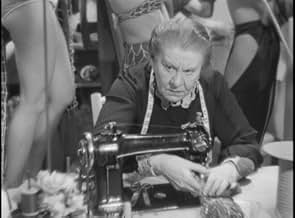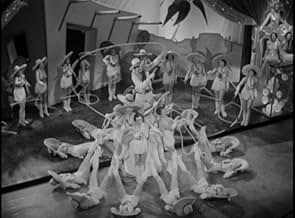VALUTAZIONE IMDb
6,5/10
1002
LA TUA VALUTAZIONE
Aggiungi una trama nella tua linguaA homicide detective with an eye for the ladies, investigating a murder in Earl Carroll's Vanities, allows the music revue to continue during the investigation.A homicide detective with an eye for the ladies, investigating a murder in Earl Carroll's Vanities, allows the music revue to continue during the investigation.A homicide detective with an eye for the ladies, investigating a murder in Earl Carroll's Vanities, allows the music revue to continue during the investigation.
Charles Middleton
- Homer Boothby
- (as Charles B. Middleton)
Ernestine Anderson
- Earl Carroll Girl
- (non citato nei titoli originali)
Lona Andre
- Lona - Earl Carroll Girl
- (non citato nei titoli originali)
William Arnold
- Treasurer
- (non citato nei titoli originali)
Lucille Ball
- Earl Carroll Girl
- (non citato nei titoli originali)
Lucille Battle
- Black Dancer in Ebony Rhapsody number
- (non citato nei titoli originali)
Trama
Lo sapevi?
- QuizMany of the Earl Carroll Girls featured in the film were authentic cast members from Carroll's stage show, which ran from September 12th to November, 1933, at the New Amsterdam Theatre, and at the Majestic Theatre from November 6th, 1933 to March 10th, 1934. These cast members were brought out to Hollywood from New York especially for this film, and many stayed to pursue film careers.
- BlooperWhen the body of the woman on the catwalk is turned on her back, you can see the actress' chest rise and fall as she takes a breath.
- Citazioni
[last lines]
Jack Ellery: Nancy, what shall I do?
Nancy: Oh, Mr. Ellery!
Jack Ellery: C'mon, let's do it.
- ConnessioniEdited into The Big Broadcast of 1937 (1936)
- Colonne sonoreEbony Rhapsody
(uncredited)
by Arthur Johnston and Sam Coslow
Sung by Carl Brisson, Kitty Carlisle and Gertrude Michael
Recensione in evidenza
This murder mystery with musical numbers is long on atmosphere and character but rather short on suspense and plausibility. Based on a stage play by Broadway showman Earl Carroll and others, it combines a whodunit plot with a backstage ambiance (a homicide investigation takes place on opening night at the theatre where a musical revue is being staged).
The cast is impressive and varied: tough-goofy Victor McLaglen as the police officer who leads the investigation and never fails to leer idiotically at whatever showgirl happens to be in sight; Jack Oakie (the prewar Jack Lemmon – or was Jack Lemmon the postwar Jack Oakie?) as the harassed director who must coordinate the staged performance as well as the chaos behind the scenes; the ever-homely Jessie Ralph as a wardrobe mistress with deep, dark secrets; Dorothy Stickney, who has a stunning close-up monologue near the end, as the tremulous maid madly in love with the male lead; Carl Brisson, the Danish star, as that very male lead, warbling the classic "Cocktails for Two" not once but twice; Kitty Carlisle, operatically delivering "Where Do They Come from and Where Do They Go" and other Johnston-Coslow songs; the glorious Gertrude Michael, who parted from us too soon, as a mean-spirited showgirl whose love for Brisson is spurned; the usually ridiculous Toby Wing who here at least is the center of a laugh-getting running joke.
When the plot complications get out of hand there is always an interesting performer or fun and tuneful musical number to distract the viewer. The film's most celebrated sequence is the "Marahuana" number, led by Michaels, but aside from its controversial history, it's really one of the lesser musical offerings. All of the songs here are staged as if they could actually have fit into a standard proscenium theatre space, as opposed to the cinematic fantasy setup of the Busby Berkeley style.
The cast is impressive and varied: tough-goofy Victor McLaglen as the police officer who leads the investigation and never fails to leer idiotically at whatever showgirl happens to be in sight; Jack Oakie (the prewar Jack Lemmon – or was Jack Lemmon the postwar Jack Oakie?) as the harassed director who must coordinate the staged performance as well as the chaos behind the scenes; the ever-homely Jessie Ralph as a wardrobe mistress with deep, dark secrets; Dorothy Stickney, who has a stunning close-up monologue near the end, as the tremulous maid madly in love with the male lead; Carl Brisson, the Danish star, as that very male lead, warbling the classic "Cocktails for Two" not once but twice; Kitty Carlisle, operatically delivering "Where Do They Come from and Where Do They Go" and other Johnston-Coslow songs; the glorious Gertrude Michael, who parted from us too soon, as a mean-spirited showgirl whose love for Brisson is spurned; the usually ridiculous Toby Wing who here at least is the center of a laugh-getting running joke.
When the plot complications get out of hand there is always an interesting performer or fun and tuneful musical number to distract the viewer. The film's most celebrated sequence is the "Marahuana" number, led by Michaels, but aside from its controversial history, it's really one of the lesser musical offerings. All of the songs here are staged as if they could actually have fit into a standard proscenium theatre space, as opposed to the cinematic fantasy setup of the Busby Berkeley style.
I più visti
Accedi per valutare e creare un elenco di titoli salvati per ottenere consigli personalizzati
- How long is Murder at the Vanities?Powered by Alexa
Dettagli
- Data di uscita
- Paese di origine
- Lingua
- Celebre anche come
- Murder at the Vanities
- Luoghi delle riprese
- Azienda produttrice
- Vedi altri crediti dell’azienda su IMDbPro
- Tempo di esecuzione1 ora 29 minuti
- Colore
- Proporzioni
- 1.37 : 1
Contribuisci a questa pagina
Suggerisci una modifica o aggiungi i contenuti mancanti

Divario superiore
By what name was Il mistero del varietà (1934) officially released in India in English?
Rispondi



































